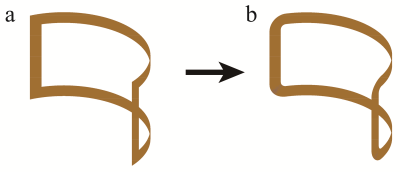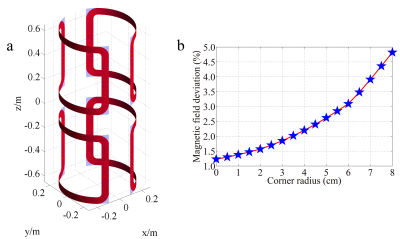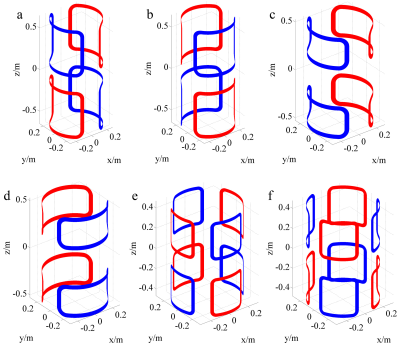1479
Superconducting shim coil design using a quasi-saddle geometry1Institute of Electrical Engineering, Chinese Academy of Sciences, Beijing, China, 2School of Electronic, Electrical and Communication Engineering, University of Chinese Academy of Sciences, Beijing, China, 3School of Information Technology and Electrical Engineering, The University of Queensland, Brisbane, Australia, 4School of Biomedical Engineering, Southern Medical University, Guangzhou, China
Synopsis
An improved method was proposed to design superconducting shim coil with smooth rounded corner, which can significantly ease the winding and fabrication, and augment the magnetic field accuracy. A quantitative comparison between the shim coil using the improved strategy and the conventional standard design shows clear advantage.
Introduction
In MRI, the static magnetic field quality is highly-related to the final image quality. The magnet field uniformity inside the imaging area is theoretically designed within a few ppm. However, during the magnet fabrication, transportation and installation, the field homogeneity is inevitably suffered. Thus, effective shimming measures are usually essential to compensate the homogeneity loss. Superconducting shim coil design is such a measure to offset the spherical harmonic components of the impaired static magnetic field so as to significantly improve the field homogeneity1. In this abstract, a quasi-saddle geometry was proposed to ameliorate the magnetic field performance degeneration due to coil winding and the performance comparison between the proposed strategy and the conventional saddle-geometry scheme was quantitatively conducted2, 3.Methods
The magnetic field in the imaging area of an MRI magnet can be expressed as a summation of spherical harmonics series2. $${B_z(x,y,z)=\begin{align}a_{00}&+a_{10}z&+a_{20}(2z^2-x^2-y^2)\\{}&+a_{11}x&+a_{21}xz\\{}&+b_{11}y&+b_{21}yz\\{}&{}&+a_{22}(x^2-y^2)\\{}&{}&+b_{22}xy\end{align}}$$ Superconducting shim coil is designed to produce a magnetic field profile corresponds to a specific order of the spherical harmonics. For tesseral coil design, saddle loop was typically used as the base geometry, as shown in Fig. 1(a). Actually, when winding the saddle coil with superconducting wires, a smooth connection is necessary from the arc section to the straight section, forming a rounded corner, as illustrated in Fig. 1(b). The rounded corner makes the magnetic field profile of the shim coil deviates from the original design target.
It is necessary to eliminate the magnetic field deviation aroused by rounded corner winding with an integral design strategy, namely taking the corner directly into consideration during the design process. Here, we consider the corner as a round/smooth connection and set its inner radius as 0.1 of the arc length. If the current density of the quasi-saddle coil is J0, a discrete-wire format can be applied to compute the corresponding magnetic field4: $${B_z(r)=\sum\limits_{i=1}^{M}\sum\limits_{j=1}^{N}{\frac{J_0s_idl_j\times(r-l_j)}{|r-l_j|}}}$$
where si is the cross section of the wire and lj is the wire segment.
Results
Taking $$${a_{11}}$$$ shim coil design as an example, the shim coil design with standard saddle coil and corresponding quasi-saddle pattern after winding was illustrated in Fig. 2(a). The radius of the shim coil is 0.277 m with a length no longer than 1.30 m, and the maximum magnetic field deviation constraint is 1%. Fig. 2(b) shows the maximum magnetic field deviation variation with respect to the increasing of the corner radius. Even though in the limit case where the radius is 0, the magnetic field deviation is still drifted from the designed 1% to 1.23%. The winding-induced magnetic field deviation is shown in Fig. 3, where Fig. 3(a) displays the magnetic field deviation of the original coil design and Fig. 3(b) presents that of the wound coil with corner radius 3 cm. It is obvious that the magnetic field area with identical homogeneity has reduced and the maximum magnetic field deviation reaches 1.85%.
The magnetic field deviations of a set of shim coils with a 3-cm winding corner after winding were listed in Table I. During the design with standard saddle geometry, all the coils have a maximum magnetic field deviation constraint 1% and length no longer than 1.30 m.
Based on the proposed design strategy, one- and two-order shim coils were designed, as presented in Fig. 4. All the coils have a maximum magnetic deviation constraint 1% and a corner radius to arc length ratio 0.1.
Discussion
The corner radius to arc length ratio can be adjusted according to the superconducting wire performance and the coil dimension, which does not affect the magnetic field deviation from the designated level.Conclusion
This work proposed a superconducting shim coil design method that applied a quasi-saddle geometry into coil optimization, effectively eliminating the magnetic field deviation due to rounded-corner phenomenon during winding. Moreover, the improved coil configuration eased the coil layout, enhanced the coil stability, and increased the fabrication accuracy.Acknowledgements
This work is funded by CAS Pioneer Hundred Talents Program (grant No. Y8402A1C31).References
1. F. Roméo and D. I. Hoult. Magnet field profiling: Analysis and correcting coil design. Magnetic Resonance in Medicine. 1984; 1: 44-65.
2. P. Konzbul and K. Sveda. Shim coils for NMR and MRI solenoid magnets. Measurement Science and Technology. 1995; 6: 1116.
3. Z. Ni, L. Li, G. Hu, C. Wen, X. Hu, F. Liu, et al. Design of Superconducting Shim Coils for a 400 MHz NMR Using Nonlinear Optimization Algorithm. IEEE Transactions on Applied Superconductivity. 2012; 22: 4900505.
4. Y. Wang, F. Liu, X. Zhou, and S. Crozier. Design of transverse head gradient coils using a layer-sharing scheme. Journal of Magnetic Resonance. 2017; 278: 88-95.
Figures




